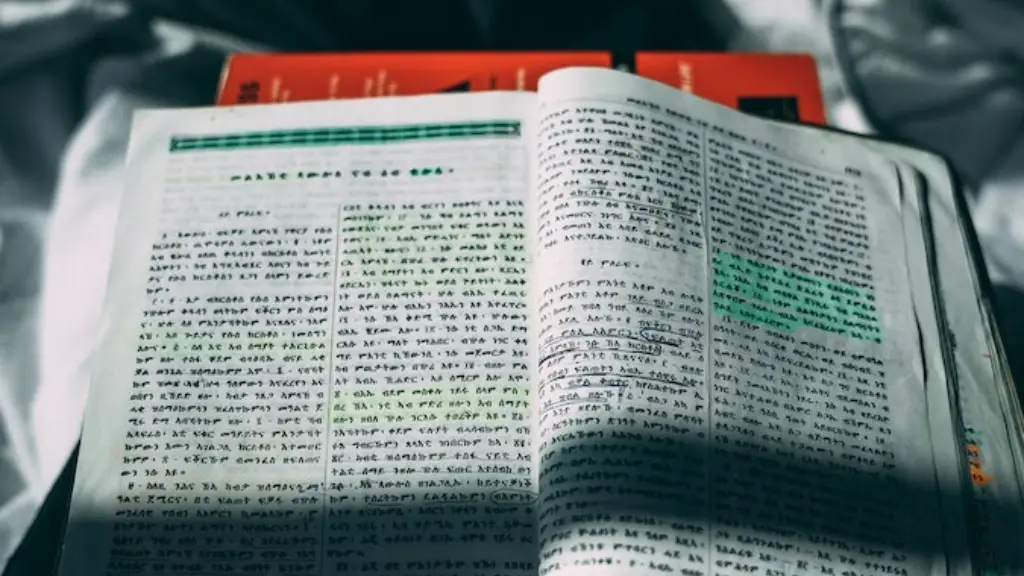Syllables: the Building Blocks of Poetry
The combination of syllables into poetry is the fundamental building block of any form of creative expression. Being able to identify when syllables are stressed or unstressed is essential for deciphering the flow and understanding of a piece of writing. Knowing how to determine stressed and unstressed syllables builds on the ability to comprehend a poem and its emotions.
Syllables form the basis of spoken languages around the world as each word has a syllabic structure. In poetry, these syllables take on an even greater importance as they are manipulated and crafted to express the desired sentiments of the poet. By being able to successfully distinguish between them, the layers of meaning and emotion are unpacked.
The syllable is determined by its length in time, known as the duration. In English, syllables can be either short or long – the long syllables are known as stressed syllables. Stressed syllables are longer, deeper and louder than their unstressed counterparts and as such hold a greater emphasis within the poem. This emphasis is what creates the ‘flow’ of the poem, and is best understood by identifying when syllables are stressed or unstressed.
Stressed syllables are most commonly found at the beginning of words and must be correctly identified to comprehend the poem. To do this without the text in front of them, poets often use metrical patterns. This is a pattern based on sound that indicates where the stressed syllables should be. For example, the ‘iambic pentameter’ is a common metrical pattern, where each line of a poem is made up of five iambs which consist of one short, unstressed syllable followed by one longer, stressed syllable.
For those trying to determine unstressed syllables, the process is just as important and notably more complex. Unstressed syllables are often considered to be nonessential parts of a word and so can be omitted when reading. This is important to consider when identifying unstressed syllables, as they are often the ignored elements when decoding a poem.
Seeking out a teacher or even simply reading a book discussing poetic techniques can be helpful. By engaging in an understanding of these techniques, determining stressed and unstressed syllables in poetry quickly becomes easier. Poets like Edgar Allan Poe, who notoriously used syllables to craft his pieces, note the importance of finding the connection between syllables and emotion.
Listening Closely to Syllables
Discovering the potentially hidden emotions within a poem requires a cerebral and intimate understanding of a poem and its syllables. To truly understand stressed and unstressed syllables, it is important to note the disruption in the flow of the poem – if any. One way to do this would be to read the poem aloud, actually listening to the syllables and how their sound is affected by the stresses and unstresses.
The ability to determine when a syllable is stressed or unstressed can be improved simply by reading poetry. By being able to recognize the disruption in end rhymes or internal rhymes, or the break of metrical patterns, the reader can note the importance of a syllable as either stressed or unstressed. As sounds combine and create emphases, subtle emotions of the poet that are chosen to be conveyed are revealed.
Engaging in the nuance of each syllable is often the only way to reach the core of the poem. By taking the time to figure out the meaning of each syllable both on the page and in the sound it creates, a reader has the ability to develop a greater understanding of the poem and its story.
Creating Meaning Through Syllables
By noting the importance of each syllable, the reader can begin to interpret both the literal and figurative meanings of a poem. This understanding of the sound structure in poetry can also be used to create imagery or puzzle-like structure on the page so that each syllable can be analyzed for its purpose. Through this process, syllables can be matched with particular emotions or moments, and the poem can take new meaning.
The ability to truly understand a poem is then grown through the examination of each nuanced syllable. By doing this, the reader can build on their understanding of the poem in both its sound and its message, to obtain a greater understanding of the poet’s intent. It is this ability to recognize the small differences between each syllable that lends to a greater understanding of the poem as a whole.
It is crucial to appreciate each syllable as an important part of a poem and to interpret its sound and meanings accordingly. This allows the reader to delve into their understanding of the vein of emotion presented by the poet. Through being able to determine when syllables are stressed or unstressed, a greater depth of interpretation can be reached and the secrets of the poem can be revealed.
Exploring Figures of Speech and Metaphors
By developing the ability to understand not only when syllables are stressed or unstressed, but also when they are combined to form complex phrases, new levels of analysis can be reached in a poem. Identifying metaphors and figures of speech within the structure of the poem is highly beneficial in obtaining a deeper understanding of a poem and its emotion. A figure of speech is a word or phrase used to add emphasis or emotion. Examining its use and purpose in the poem can provide greater insight into the phrase as a whole.
For example, a metaphor is when a simile is used to compare two seemingly unrelated concepts. By deciphering the hidden underlying meaning of each syllable and its place in the poem’s structure, the reader is better able to identify how metaphor is used within the poem. Symbols are also used in poetry to communicate ideas, and by having the ability to determine when syllables are stressed or unstressed, a reader can note these symbols and gain a greater appreciation for their use in the poem.
Figures of speech are unique devices used to convey emotion. By understanding these figures of speech, a reader can build on their understanding of the poem and the emotion it conveys. This is achieved, in part, through being able to identify the way stressed and unstressed syllables are utilized in the poem, and then being able to recognize what type of figures of speech are being used in order to communicate their meaning.
Building Skills to Interpret Poetry
Determining stressed and unstressed syllables in poetry is an acquired skill, and one which can be assessed and developed with practice. By engaging in constant reading and focusing on the pronunciation of the poem and its syllables, one can begin to discern the words meaning and purpose within the poem more easily.
It is also beneficial to read and analyse the works of poets from all ages, as these will give a better understanding of the variation of sound-based structures and the way different eras used their syllables. All in all, by building on their appreciation of syllabic structure, a reader can begin to reach a higher level of interpretation of any poem.
The Power of Prefixes and Suffixes
As noted, determining syllables and their stresses and unstresses requires a full concept of the English language in terms not just of pronunciation, but also of prefixes, suffixes and other terms. Unique and nuanced words which convey a specific meaning within the poem can be formed through the crafty use and arrangement of these. A reviewer should focus on the combination of words, to identify how prefix and suffix are used to create a unique meaning.
The importance of these elements within the poem should not be underestimated, as they can often be used to give insight into the writer’s thought process and building of the poem. For example, the use of a prefix or suffix may reflect the poet’s feelings or can give insight into the complexity of the theme of the poem. Understanding and deciphering these elements of the poem will give the reader a greater understanding of it as a whole.
The use of prefixes and suffixes in poetry is also important to note as they can help the reader to understand and identify the different sounds of the syllables. Prefixes and suffixes can – depending on their form – affect the way a syllable is identified. For example, the prefix “re-” can indicate a stressed syllable: a re-member, a re-tell, a re-peat. This type of sound structure can be used to create interesting and unique effects within the poem.
The Finite Language of Poetry
For it not just to be recited with rhythm, a poem needs to be read closely, so as to truly understand the chosen syllables and their purpose. Capitalizing on the nuances of different languages is key, as the poet often gives particular words or phrases more gravity or emphasis than others. In modern poetry, this can often mean dictionary-like words being given a unique sound structure. These words can be used to expertly craft the poem, allowing each syllable to be used to its fullest potential.
By exploring the different sounds of a poem, a reader can better identify its subtleties, which may otherwise remain hidden. Knowing exactly when each syllable is stressed or unstressed is a foundational skill needed to truly appreciate any form of poetry. With a greater appreciation of the importance of stressed and unstressed syllables, the reader can then make the connection between individual sounds and the poem’s overall emotion.
Analyzing Syllables on the Page
Mapping the page is another technique for discovering an appreciation for the subtle emotion in a poem. This can be done by placing a series of graphemes – or thought bubbles – around certain words and phrases in order to mark certain words as important. This technique allows the reader to revisit these areas and truly dive into their importance with respect to the sound and sentiment of the poem.
A poem’s structure, by extension, is used to provide insight on the emotions that the poet is trying to show. Using syllable stress to identify how phrases are constructed can help to appreciate how this structure is used to evoke emotion. Being able to determine when syllables are stressed or unstressed can give insight into the way emotions of a poem are understood, as well as determining the metre and rhythms of the poem.
This can be used to discuss a more advanced form of poetic analysis, as the focus then turns to the physical structure of the poem, the typeface and uses of italics or bold text. By looking at these and understanding why the poet has chosen to construct their poem in a certain way, an even more intimate analysis of their meaning can be reached.
Echoing Through Each Word
Being able to determine when syllables are stressed or unstressed is a widely sought-after skill for poets and critics alike. Recognizing the two extremes and how the middle ground can be created facilitates a unique appreciation for how the poem is crafted in order to best isolate and transmit emotion. The aptness or appropriateness of the words chosen can also give insight into the overall structure of the poem.
As each poet has their own style and each syllable its own power, understanding where and when to emphasize words can be used to pick out the heartbeat of the poem. This is a form of translation, as the poem is rendered into an emotion which is accessible by a reader. It is this translation which is the ultimate goal: to make the poem something that can be felt, not just read.
Each stressed or unstressed syllable provides a fundamental building block for a poem, and without the ability to determine between them, a reader would be missing a great part of the poem’s potential. By being able to recognize the differences, a person can gain a greater insight and appreciation for the poem and its feelings.





